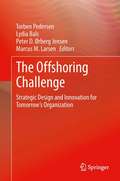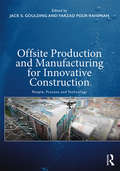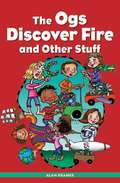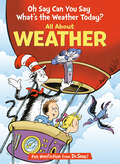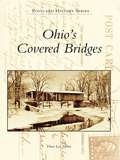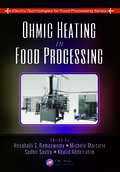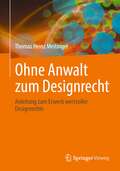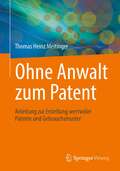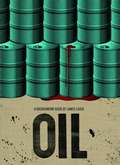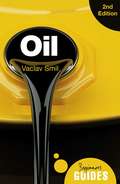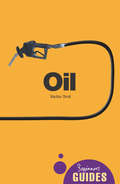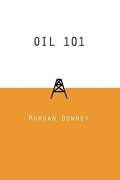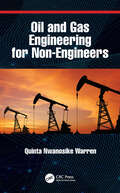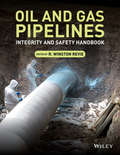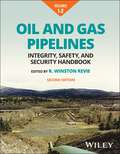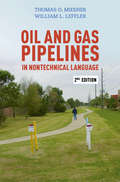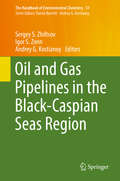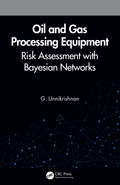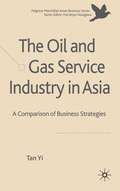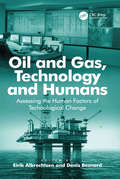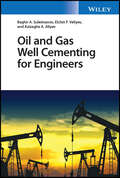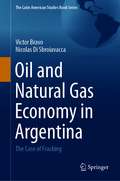- Table View
- List View
The Offshoring Challenge
by Torben Pedersen Lydia Bals Peter D. Ørberg Jensen Marcus M. LarsenThe continuous search for efficiency gains and the goal of attaining a sustainable competitive advantage have steadily increased the volume of goods and services procured globally from third party vendors. In this context, named as "the next wave of globalization", the offshoring phenomenon has stimulated research and political debates. With the rise of services offshoring, international value chain disaggregation for services has reached a formerly unknown scale. Also, it is increasingly complex transactions, requiring a higher degree of qualification, which are becoming subject to offshoring as well. The Offshoring Challenge: Strategic Design and Innovation for Tomorrow's Organization features selected chapters by an international research community on the topic of offshoring. All potential business models from offshore outsourcing to third party providers are covered, from cooperative arrangements to internal organizational set-ups including captive offshore centers. Contributions have significant insights regarding: the increasing offshoring of knowledge-intensive services; the offshoring process; business models incorporating offshoring; the hidden costs of offshoring; and the administration of offshoring activities within firms The book is aimed at a broad audience of scholars, students and practitioners in the fields of strategy, international business and operations management.
Offsite Production and Manufacturing for Innovative Construction: People, Process and Technology
by Jack S. Goulding Farzad Pour RahimianThe offsite and modular market is continuing to grow. This book builds on the success of a number of initiatives, including formative findings from literature, research and development and practice-based evidence (success stories). It presents new thinking and direction from leading experts in the fields of: design, process, construction, engineering, manufacturing, logistics, robotics, delivery platforms, business and transformational strategies, change management, legislation, organisational learning, software design, innovation and biomimetics. This book is particularly novel and timely, as it brings together a number of cogent subjects under one collective ‘umbrella’. Each of these chapters contain original findings, all of which culminate in three 'Key Learning Points' which provide new insight into the cross-cutting themes, interrelationships and symbiotic forces that exist between each of these chapters. This approach also provides readers with new contextualised understanding of the wider issues affecting the offsite market, from the need to embrace societal challenges, through to the development of rich value-laden solutions required for creating sector resilience. Content includes a balance between case studies and practice-based work, through to technical topics, theoretical propositions, pioneering research and future offsite opportunities ready for exploitation. This work includes: stakeholder integration, skills acquisition, new business models and processes, circularity and sustainable business strategies, robotics and automation, innovation and change, lean production methodologies and new construction methods, Design for Manufacturing and Assembly, scaled portfolio platforms and customisability, new legal regulatory standards and conformance issues and offsite feasibility scenario development/integration.
The Ogs Discover Fire and Other Stuff: Set of 6 (Navigators Ser.)
by Alan Kramer Anita DuFalla Alison AdamsNIMAC-sourced textbook
Oh Say Can You Say What's the Weather Today? All About Weather: All About Weather (The Cat in the Hat's Learning Library)
by Tish RabeLaugh and learn with fun facts about the sun, thunderstorms, snowflakes, and more—all told in Dr. Seuss&’s beloved rhyming style and starring the Cat in the Hat! &“You see, weather keeps changing, but one thing we know. It makes life exciting wherever you go.&” The Cat in the Hat&’s Learning Library series combines beloved characters, engaging rhymes, and Seussian illustrations to introduce children to non-fiction topics from the real world! Look up in the sky and learn: • how to read a weather map• what the water cycle is• how meteorologists forecast the weather• and much more! Perfect for story time and for the youngest readers, Oh Say Can You Say What's the Weather Today? All About Weather also includes an index, glossary, and suggestions for further learning. Look for more books in the Cat in the Hat&’s Learning Library series!If I Ran the Horse Show: All About HorsesClam-I-Am! All About the BeachMiles and Miles of Reptiles: All About ReptilesA Whale of a Tale! All About Porpoises, Dolphins, and WhalesSafari, So Good! All About African WildlifeThere's a Map on My Lap! All About MapsOh, the Lavas That Flow! All About VolcanoesOut of Sight Till Tonight! All About Nocturnal AnimalsWhat Cat Is That? All About CatsOnce upon a Mastodon: All About Prehistoric MammalsThe Cat on the Mat: All About Mindfulness
Ohio's Covered Bridges (Postcard History Series)
by Elma Lee MooreMore than 200 of Ohio's historic covered bridges, some of which have survived and many that have not, are once again captured in Dr. Elma Lee Moore's Ohio's Covered Bridges. Classic images of these treasured bridges that have spanned Ohio's rivers, creeks, streams, and gorges are presented in vintage postcards of the past. The GPS location is listed for each existing bridge.
Ohmic Heating in Food Processing (Electro-Technologies for Food Processing Series)
by Hosahalli S. Ramaswamy Michele Marcotte Sudhir Sastry Khalid AbdelrahimOhmic heating provides rapid and uniform heating, resulting in less thermal damage than conventional heating and allowing manufacturers to obtain high-quality products with minimum sensorial, nutritional, and structural changes. Ohmic Heating in Food Processing covers several aspects of Ohmic heating: science and engineering, chemistry and physics,
Ohne Anwalt zum Designrecht: Anleitung zum Erwerb wertvoller Designrechte
by Thomas Heinz MeitingerDer Erwerb eines Designrechts erscheint problemlos und kostengünstig. Einfach ein paar Fotos gemacht und schon kann ein Designschutz beantragt werden. Diese etwas unbedachte Vorgehensweise kann sich als Boomerang herausstellen. Die Abbildungen des Designrechts sind tatsächlich entscheidend. Es sind allerdings einige Dinge zu beachten, um einen effektiven Designschutz zu erhalten. Spätestens bei einer gerichtlichen Durchsetzung des Designrechts kann sich herausstellen, dass eine gewissenhafte Erstellung des Designrechts notwendig ist. Zur Realisierung der Vorteile eines Designrechts ist ein grundlegendes theoretisches Verständnis erforderlich. Außerdem sollten einige Lehren aus der Praxis beachtet werden. Dieses Fachbuch bietet beides. Es präsentiert die theoretischen Grundlagen, um sicher mit den Gestaltungselementen des Designrechts umzugehen. Außerdem geben eine Vielzahl von Beispielen aus der Praxis Sicherheit bei der Anmeldung und Durchsetzung eines Designrechts.
Ohne Anwalt zum Patent: Anleitung zur Erstellung wertvoller Patente und Gebrauchsmuster
by Thomas Heinz MeitingerDieses Fachbuch dient dazu, Patent- oder Gebrauchsmusteranmeldungen selbst zu erstellen. Es werden die erforderlichen Bestandteile einer Anmeldung beschrieben und Formulierungsvorschläge gegeben. Eine Vielzahl von Beispielen aus der Praxis geben zusätzliche Orientierung. Der Aufbau des Fachbuchs entspricht dem empfohlenen Ablauf bei der Erstellung einer Anmeldung. Zunächst wird beschrieben, wie in der Anmeldung der Stand der Technik erläutert wird. Der Stand der Technik stellt den Ausgangspunkt der Schöpfung der Erfindung dar. Aus der Beschäftigung mit dem Stand der Technik stellt der Erfinder Nachteile fest, die ihn zu seiner Erfindung veranlassen. Die Nachteile führen zur Aufgabe der Erfindung. Dieser Werdegang der Erfindung ist in der Anmeldung wiederzugeben. Als nächsten Schritt der Ausarbeitung einer Anmeldung folgt eine Beschreibung der verschiedenen Ausführungsformen der Erfindung. Schließlich werden die Ansprüche formuliert. Dieser Ablauf hat den Vorteil, dass erst am Ende der Bearbeitung der schwierigste Schritt erfolgt, nämlich das Formulieren der Ansprüche. Der Erfinder weist daher bei der Formulierung der Ansprüche eine profunde Kenntnis der verschiedenen Aspekte seiner Erfindung auf, was ihm das Abfassen der Ansprüche erheblich erleichtern wird.
Ohne Anwalt zur Marke: Anleitung zum Erwerb wertvoller Marken
by Thomas Heinz MeitingerDas Fachbuch vermittelt das komplette Know-How zur Administration einer Marke, von dem Finden eines Markennamens, der Bestimmung der Waren und Dienstleistungen und der Wahl der Markenform. Es wird beschrieben, bei welchem Patentamt eine Marke angemeldet werden kann. Die Markenrecherche, die Markenberwachung und das Durchsetzen einer Marke nehmen weitere Schwerpunkte ein. Auerdem werden die rechtlichen Möglichkeiten erlutert, sich gegen strende Marken zu wehren und das Fachbuch zeigt auf, wie Marken aufrechterhalten und sinnvollerweise gemanagt werden.
OHS Electronic Management Systems for Construction (Spon Research)
by Imriyas KamardeenOccupational accidents have a massive personal and social cost as well as a major financial cost. The construction industry is one of the most dangerous industries, accounting for around 20–30% of all occupational deaths worldwide. The accompanying financial cost is either absorbed directly or passed on in the form of higher insurance costs. In addition, regulatory bodies have started to impose legal accountability on all the parties along the construction supply chain.OHS is hard to implement. Construction projects are complex, with a fluid workforce, and the regulatory framework is highly elaborate. OHS Electronic Management Systems for Construction presents a theoretical framework which is designed to overcome these difficulties, integrating OHS management in construction using knowledge management and web technologies. This framework is explained in a clear step-by-step way, as are features such as a systematically developed corporate safety memory, and a virtual learning portal to facilitate on-demand safety training.The ultimate aim of this book is to aid the development of an established safety culture at the organisational level, and the formation of an industry-wide community of safety practice. This is essential reading for OHS professionals and construction managers attempting to change their industry for the better, as well as advanced students and researchers.
Oil: A Groundwork Guide
by James LaxerIn this lucid and compelling book, James Laxer introduces readers to the contested history of oil, from the first oil wells in the Russian Empire, Canada and the US in the 1840s and 1850s to the frenzied debate about "peak oil" in the early twenty-first century and the daunting specter of a post-oil world. Laxer carefully examines the multiple effects of oil consumption and production worldwide.
Oil: A Beginner's Guide (Beginner's Guides)
by Vaclav SmilWorld acclaimed scientist Vaclav Smil reveals everything there is to know about nature's most sought-after resourceOil is the lifeblood of the modern world. Without it, there would be no planes, no plastic, no exotic produce, and a global political landscape few would recognise. Humanity&’s dependence upon oil looks set to continue for decades to come, but what is it? Fully updated and packed with fascinating facts to fuel dinner party debate, Professor Vaclav Smil's Oil: A Beginner's Guide explains all matters related to the &‘black stuff&’, from its discovery in the earth right through to the controversy that surrounds it today.
Oil
by Vaclav SmilPacked with fascinating facts and insight, this book will fuel dinner party debate, and provide readers with the science and politics behind the world's most controversial resource. Without oil, there would be no globalisation, no plastic, little transport, and a global political landscape that few would recognise. It is the lifeblood of the modern world, and humanity's dependence upon it looks set to continue for decades to come. In this captivating book, the author of the acclaimed Energy: A Beginner's Guide, Vaclav Smil, explains all matters related to the 'black stuff', from its discovery in the earth, right through to the political maelstrom that surrounds it today. Author Vaclav Smil is Distinguished Professor in the Faculty of Environment at the University of Manitoba, Canada. He has written over 10 books on energy and been a keynote speaker at both the World Economic Forum and the Global Roundtable on Climate Change. He is the first non-American to receive the American Association for the Advancement of Science Award for Public Understanding of Science and Technology and is a Special Fellow of the Royal Society.
Oil 101
by Morgan DowneyOIL 101 is a straightforward guide to oil and an essential read for anyone coming to grips with where oil prices, the economy and society are headed. <p><p> In OIL 101, Downey provides the facts one needs to understand oil, from its history and chemistry, to refining, finished products, storage, transportation, alternatives, and how prices are determined every day in global wholesale oil markets and how those markets are connected to prices at the pump.
Oil and Gas Engineering for Non-Engineers
by Quinta Nwanosike WarrenOil and Gas Engineering for Non-Engineers explains in non-technical terms how oil and gas exploration and production are carried out in the upstream oil and gas industry. The aim is to help readers with no prior knowledge of the oil and gas industry obtain a working understanding of the field. Focuses on just the basics of what the layperson needs to know to understand the industry Uses non-technical terms, simple explanations, and illustrations to describe the inner workings of the field Explains how oil is detected underground, how well locations are determined, how drilling is done, and how wells are monitored during production Describes how and why oil and gas are separated from impurities before being sent to customers Aimed at non-engineers working within the oil and gas sector, this book helps readers get comfortable with the workings of this advanced field without the need for an advanced degree in the subject.
Oil and Gas Pipelines: Integrity and Safety Handbook
by R. Winston RevieA comprehensive and detailed reference guide on the integrity and safety of oil and gas pipelines, both onshore and offshore Covers a wide variety of topics, including design, pipe manufacture, pipeline welding, human factors, residual stresses, mechanical damage, fracture and corrosion, protection, inspection and monitoring, pipeline cleaning, direct assessment, repair, risk management, and abandonment Links modern and vintage practices to help integrity engineers better understand their system and apply up-to-date technology to older infrastructure Includes case histories with examples of solutions to complex problems related to pipeline integrity Includes chapters on stress-based and strain-based design, the latter being a novel type of design that has only recently been investigated by designer firms and regulators Provides information to help those who are responsible to establish procedures for ensuring pipeline integrity and safety
Oil and Gas Pipelines: Integrity, Safety, and Security Handbook
by R. Winston RevieDiscover the integrity, safety, and security of new and aging oil and gas pipelines in this comprehensive reference guide Oil and gas pipelines are typically used to transport oil and gas, but can be adapted to transport ethanol, carbon dioxide, hydrogen, and more. A pipeline network is an efficient method for transporting any number of energy-providing products, but safety and integrity are critical aspects of pipeline integrity management. The demand for pipeline safety and security is increasing in the face of more stringent standards and deepening environmental concerns, including those related to climate change. Oil and Gas Pipelines: Integrity, Safety, and Security Handbook provides a comprehensive introduction to the integrity of new and aging pipelines and their management, repair, and maintenance. All major varieties of pipeline are included, along with all pertinent public safety and environmental protections. Now fully updated to reflect the latest research and technological developments, the book is a critical contribution to the reliability and safety of the global energy grid and ongoing efforts at carbon capture, utilization, and storage. Readers of the second edition of Oil and Gas Pipelines will also find: 26 new chapters including a new section on the digitalization of pipelinesDetailed discussion of topics including management of geohazards, mechanical damage, internal corrosion monitoring, and many moreExtensive case histories with practical accompanying solutions Oil and Gas Pipelines is ideal for engineers, scientists, technologists, environmentalists, students, and others who need to understand the basics of pipeline technology as it pertains to energy deliverability, environmental protection, public safety, and the important role of pipelines and pipeline security to ensure energy security during the energy transition.
Oil and Gas Pipelines in Nontechnical Language, 2nd Edition
by Thomas O. Miesner William L. LefflerA totally understandable view of pipeline inception, planning, construction, start-up, and operation.
Oil and Gas Pipelines in the Black-Caspian Seas Region
by Sergey S. Zhiltsov Igor S. Zonn Andrey G. KostianoyThis book concisely describes the architecture of the oil and gas pipelines in the Black-Caspian Seas Region and analyzes the status quo and perspectives of oil and gas production in this region. The authors present numerous projects, each of which has made a substantial contribution to the development of pipeline transport and transit in this part of the world, and discuss them in detail. The topics covered include: the region's geographic characteristics; the region's hydrocarbon potential; Russian and EU policy on pipeline transport; Kazakhstan's pipeline policy; Chinese pipeline projects; the Bulgarian gas transmission system; environmental risks in the production and transportation of hydrocarbons; satellite monitoring; and subsea leak detection. This volume offers a valuable resource for politicians, specialists in the oil and gas business, decision-makers, and environmentalists alike.
Oil and Gas Processing Equipment: Risk Assessment with Bayesian Networks
by G. UnnikrishnanOil and gas industries apply several techniques for assessing and mitigating the risks that are inherent in its operations. In this context, the application of Bayesian Networks (BNs) to risk assessment offers a different probabilistic version of causal reasoning. Introducing probabilistic nature of hazards, conditional probability and Bayesian thinking, it discusses how cause and effect of process hazards can be modelled using BNs and development of large BNs from basic building blocks. Focus is on development of BNs for typical equipment in industry including accident case studies and its usage along with other conventional risk assessment methods. Aimed at professionals in oil and gas industry, safety engineering, risk assessment, this book Brings together basics of Bayesian theory, Bayesian Networks and applications of the same to process safety hazards and risk assessment in the oil and gas industry Presents sequence of steps for setting up the model, populating the model with data and simulating the model for practical cases in a systematic manner Includes a comprehensive list on sources of failure data and tips on modelling and simulation of large and complex networks Presents modelling and simulation of loss of containment of actual equipment in oil and gas industry such as Separator, Storage tanks, Pipeline, Compressor and risk assessments Discusses case studies to demonstrate the practicability of use of Bayesian Network in routine risk assessments
The Oil and Gas Service Industry in Asia
by Tan YiThis book investigates the business strategies chosen by oil and gas service companies operating in China, Singapore and Malaysia. It provides an analytical view of the reliability of strategic theoretical frameworks based on Western business practice but applied in a non-Western business environment like Asia.
Oil and Gas, Technology and Humans: Assessing the Human Factors of Technological Change
by Eirik Albrechtsen Denis BesnardThe oil and gas industry is going through a major technological shift. This is particularly true of the Norwegian continental shelf where new work processes are being implemented based on digital infrastructure and information technology. The term Integrated Operations (IO) has been applied to this set of new processes. It is defined by the Centre for Integrated Operations in the Petroleum Industry as 'work processes and technology to make smarter decisions and better execution, enabled by ubiquitous real time data, collaborative techniques and access to multiple expertise'. It's claimed that IO is efficient, optimises exploration, reduces costs and improves safety performance. However, the picture is not as clear-cut as it may appear. On the one hand, the new work processes do not prevent major accidents: IO-related factors have been identified in recent events such as the Deepwater Horizon catastrophe. On the other hand, IO technology provides improved decision-making support (such as access to real-time data and expertise), which can reduce human and material losses and damage to the environment. Given these very different properties, it's vital that the industry has a detailed understanding of the benefits and drawbacks of IO, which this book sets out to do from a multidisciplinary point of view. It analyses Integrated Operations from the angles of statistics, management science, human factors and resilience engineering. These varied disciplines provide a multifaceted understanding of IO that better informs risk assessment practices, as well as explaining new techniques and methods and provides state-of-the-art guidance to risk assessment practitioners working in the oil and gas industry.
Oil and Gas Well Cementing for Engineers
by Baghir A. Suleimanov Elchin F. Veliyev Azizagha A. AliyevOil and Gas Well Cementing for Engineers Practical approach covering the chemistry, processes, and modeling in the field of cementing engineering Oil and Gas Well Cementing for Engineers is a comprehensive and reader-friendly book that delves into the chemistry, processes, and modeling involved in cementing engineering in the oil and gas industry. The book brings together traditional cementing technologies and the latest advancements, providing a practical approach for both students and field specialists. It then proceeds to cover the entire cementing process, including the initial phase of Portland cement production and practical calculations needed during complex cementing operations. In a rapidly evolving industry, where the number of well workover and bottom-hole zone stimulation operations is on the rise, understanding cementing systems and cementing technology is crucial for field operation efficiency. This book fills the knowledge gap often left by educational institutions that fail to provide well cementing as a separate course, opting to cover only fragments of the process within related subjects. Oil and Gas Well Cementing for Engineers serves as an essential primer for students, offering a comprehensive overview of cementing operations. For field specialists, the book provides practical insights and calculations required on-site, making it a valuable resource for enhancing operational proficiency. The logical sequence in which the material is presented simplifies the reader’s perception, making it easier to grasp the wide range of information covered in the book. Whether you are a student or an industry professional, this practical guide offers a wealth of knowledge on cementing technology, empowering you to excel in oil and gas well construction and production processes.
Oil and Governance: State-Owned Enterprises and the World Energy Supply
by David G. Victor David R. Hults Mark C. ThurberNational Oil Companies (NOCs) play an important role in the world economy. They produce most of the world's oil and bankroll governments across the globe. Although NOCs superficially resemble private-sector companies, they often behave in very different ways. Oil and Governance explains the variation in performance and strategy for NOCs and provides fresh insights into the future of the oil industry as well as the politics of the oil-rich countries where NOCs dominate. It comprises fifteen case studies, each following a common research design, of NOCs based in the Middle East, Africa, Asia, Latin America and Europe. The book also includes cross-cutting pieces on the industrial structure of the oil industry and the politics and administration of NOCs. This book is the largest and most systematic analysis of NOCs to date and is suitable for audiences from industry and academia, as well as policy makers.
Oil and Natural Gas Economy in Argentina: The case of Fracking (The Latin American Studies Book Series)
by Victor Bravo Nicolas Di SbroiavaccaThis book gathers four papers authored by Víctor Bravo and Nicolás Di Sbroiavacca, Oil and Natural Gas Engineers, specialized in Energy Economics. The main axis of the book is the application of the exploitation techniques of Oil and Natural Gas in Argentina, by the so-called “conventional” methods, in comparison with the so-called “Fracking”,(name massively used in the First World and particularly in the United States of America). Argentina has important Oil and Natural Gas resources in different regions of its wide geography. To develop these “non-conventional” techniques has generated endless controversies all over the world, mostly due to its estimated environmental impact and the need of significant requirement of large capitals for investment.Argentina is not out of this relevant controversy because in the mind of the maximum national authorities, fracking is one of the main factors that may contribute to generate monetary funds devoted to the payment of the immense foreign debt of this country. Other authors estimate that it is not possible to develop our country just on the basis of the massive exploitation and boundless export of natural resources. Consequently, fracking is undoubtedly a topic of National Energy Politics.In this scenario, a previous analysis of the National Energy Politics of the recent governments of Argentina, after the bloody military dictatorship of 1976-1983 and the return to democratic governments in December 1983. This analysis is done over the chapters “Analysis of the National Law Nº 27007 (known as the “Hydrocarbon Resources Law”) and the Oil and Natural Gas politics”, the “Oil and Natural Gas Politics of the period from 2003 to 2014” and “The Argentine Energy Politics during the 2014-2018 period”. Later on, the “Fracking” case is fully developed with two complementary analyses. One of them is basically centered on the technical and prospective scenarios for “fracking”: ”Shale Oil and Shale Gas in Argentina: Situation and Perspectives”. The other one, ”A technical opinion about Fracking”, contemplates the impacts resulting from the use of these techniques, especially those concerning the environment. Anyhow, each of the chapters are self-contained, thus permitting separate reading of any of them.
